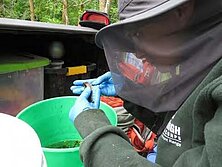
Rebecca Bradley, is in master’s program in the Biological Sciences department at North Dakota State University.
Influence of wetland water quality on amphibian stress and reproductive success in Eastern North Dakota
Research Abstract
As amphibians continue to decline, conservation efforts are a necessity in management plans and it is essential to determine the causation between water characteristics, habitat alteration, and losses. North Dakota is a segment of the Prairie Pothole Region that provides habitat for a multitude of species that rely on these wetlands. Large portions of these diverse wetlands are being lost to agriculture at unprecedented rates and as a result, habitat for these species is becoming altered or disappearing completely. Call, larval, and visual encounter surveys will be conducted to distinguish the essential habitat characteristics that are crucial during each stage of amphibian development. In addition to collecting amphibian data, macro- habitat data, micro-habitat data, and water characteristics will be recorded at each site. Water characteristics collected will include, acidity (pH), dissolved oxygen, conductivity, ammonia, nitrites, nitrates, phosphates, iron, cooper, lead, and vegetation cover. Individuals that are captured will have their blood drawn to assess environmental stress. This study allows for a determination of breeding habitat preference in anuran species while assessing blood glucocorticoid levels throughout adult, metamorph, and larval individuals. Ultimately, this data will assess how North Dakota wetland condition influences amphibian stress and reproductive success.
Research Highlights
As amphibians continue to decline globally, conservation efforts are necessary for the development of future management plans. Understanding the correlation between amphibian presence and various habitat characteristics within North Dakota wetlands is essential for amphibian conservation. Larval and visual encounter surveys were conducted and environmental data were collected in Wildlife Management Areas (WMAs) across the east-central and southeast parts of North Dakota. Water quality measurements of phosphate, nitrate, nitrite, lead, iron, copper, and ammonia were collected from each site, once a month, during the May to July field season. Surveyed WMAs can be separated into two distinct groups: sites with tadpoles present and sites without tadpoles. WMAs with tadpoles present had aver-age (min, max) measurements (mg/l) of: 1 (0, 5) phosphate, 0.26 (0, 8.3) nitrate, 0.01 (0, 4) nitrite, 0.39 (0, 4) copper, 0.13 (0, 0.5) ammonia, 0.16 (0, 1.7) iron, and 2.08 (0, 20) lead. WMAs without tadpoles had average (min, max) measurements (mg/l) of: 0.58 (0, 1) phosphate, 0.48 (0, 6.7) nitrate, 0.01 (0, 0.3) nitrite, 0.19 (0, 1) copper, 0.31 (0, 4) ammonia, 0 (0, 0) iron, and 2.72 (0, 20) lead. A multivariate analysis of variance was conducted to assess significant differences between the water characteristic levels of these two groups. Results showed a p-value of 0.054, a borderline statistically significant difference between phosphate levels in the two groups, with higher levels found in the tadpoles present group. Ultimately, this project will assess how North Dakota wetland condition in-fluences amphibian presence.

Matthew Smith
Biological Sciences
Office: Stevens 118
Phone: (701) 231-7628
Email: matthew.thomas.smith@ndsu.edu


